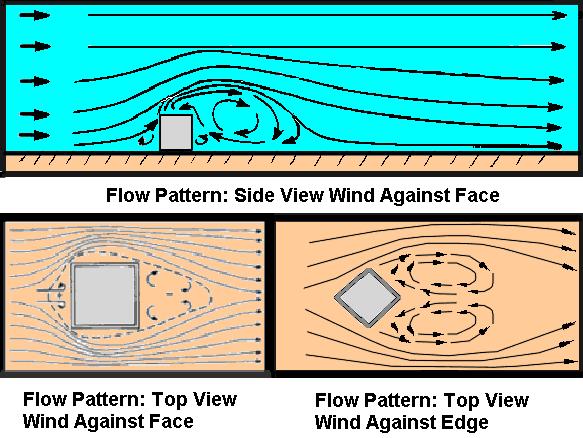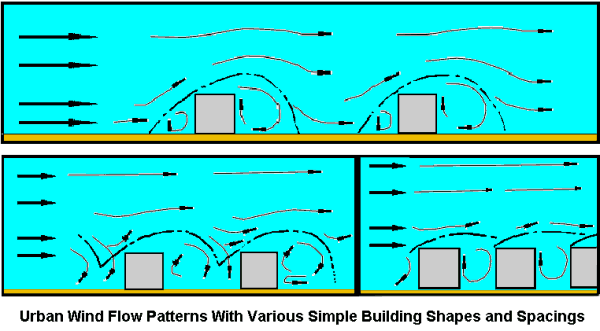 |
 |
| Home | Welcome | What's New | Site Map | Glossary | Weather Doctor Amazon Store | Book Store | Accolades | Email Us |
 | |||||||||
Winds of the CityWalk around any city where buildings rise more than a few stories, and you will experience areas with stronger and gustier winds than felt outside the urban area, at airports, or on sports fields. The prime cause of such urban winds is the redirecting of the over-ridding wind field by the structures themselves. The urban influence on winds manifests in several ways: some act to increase wind speed, others, to decrease it and all acting to alter wind directions from the overriding weather pattern. Such influences act on weather spacial scales which range in size from tens of kilometres down to metres and less. The full influence of urban areas on the regional wind field has many facets, including roughness effects and the urban heat island, which I will not detail here. Roughness acts to slow the wind, through aerodynamic drag, and increase its turbulence. Its impacts are related to the height of the roughness elements: trees, buildings, etc. that make up the city. Because cities vary greatly in the heights of their buildings, each city has its own unique roughness character. New York City, for example, would be rougher than Albany which would, in turn, be rougher than a small rural New York town which has few buildings over three stories. The urban heat island is an area centered on the city core of warmer air temperatures than those in the surrounding countryside. (See Hot Town for more.) It may produce a localized low pressure cell relative to the suburban or rural surroundings and generate an urban wind field that is superimposed on the regional wind field. Urban winds are most noticeable when regional winds are light such as at night, and like roughness, each city has its unique heat island character. Urban Canyon WindsIn this essay, I will focus on the great influences on the urban winds derived from the wide variety of building shapes, sizes, heights, separations, and orientations — with respect to flow patterns and to each other — that makes wind flows within a city quite complex. The overall impact often increases the street-level wind and directs it down separating streets and alleyways. Such wind flows are called urban canyon winds because high-rise lined streets act like canyon walls. When wind hits the face of the building, the flow splits and is diverted into several streams, the orientation and number depending on the angle of wind incidence relative to building edges and the "flatness" of the upwind building surface. For the simplest situation — a cube or rectangular solid — one flow path rises over the building and two go around it. The fourth diverts downward along the upwind face, eventually meeting the ground and then travelling back upstream to form a reverse eddy in the flow. When the main point of flow separation is high on the building or when the winds are strong, the downward stream can be strong enough to cause hazards — tossing debris and pushing pedestrians — along the upwind base of the building, particularly in narrow, tall urban canyons. And generally, the stronger the regional wind, the greater the building impacts within the urban canyons and around semi-isolated buildings.  Air Flow around a CubeThe side streams produce zones of accelerated flow near the building edges and vortices (areas of rotating flow like stationary dust devils) off the back, downwind edges of the structure. Just behind it, a dead air zone of light and chaotic flow usually forms. The stream that moves over the object top accelerates along the top upwind edge, then descends some distance downwind from the object to combine with the side vortices to produce a wake eddy. In these vortex zones, and at the points where the flow direction is diverted from the original flow, the turbulence, i.e. the gustiness, is greatly enhanced.  The situation becomes even more complex in the typical urban complex where many different shaped buildings are situated at varying distances from each other. In areas where the flow channel becomes narrower, the flow must speed up as it forces its way through. A prime example of this helps keep Chicago's reputation as the "Windy City" as winds blowing off Lake Michigan, or the open prairies to the west, channel into and down the city's east--west oriented streets. Conversely, when the channel suddenly widens, the flow must decrease in speed. (Such winds are similar to gap winds discussed last April.) In addition, each building influences the flow pattern created by the building upwind of it. Urban planners and architects are concerned over the areas of strongest winds within an urban canyon, which can be strong enough to knock you off your feet, blow objects around, and even pull glass from windows during stormy weather. Often these areas of high winds can be fixed or reduced with engineering/architectural solutions such as adding a wind break or building addition to alter the wind flow speed or direction. Learn More From These Relevant Books
|
|||||||||
 |
To Purchase Notecard, |
Now Available! Order Today! | |
 |
 |
NEW! Now Available in the US! |
The BC Weather Book: |


